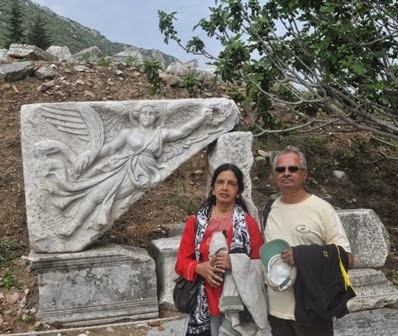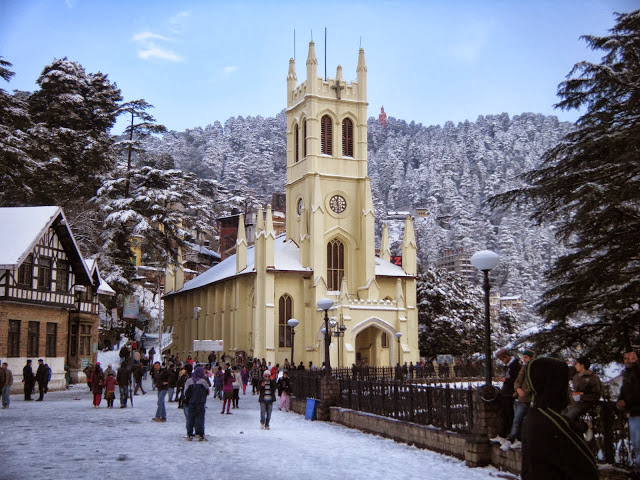On the morning of 13th
May, we had an early breakfast at 6 am and as the ship anchored at Athens,
Capital of Greece, we disembarked from the ship
We were joined by another 10
Indians, and we hired 3 taxis for taking us around Athens for 4 hours. It cost us
40 Euros per couple.
ATHENS
Athens hosted the first
modern Olympic Games
in 1896. Athens bid for the 1996 Olympics to celebrate the centenary of the
Modern Olympics but were out bid by the money power of Atlanta, USA.
Athens, the city with a glorious
history, a city worshipped by gods and people, is a magical city. The
enchanting capital of Greece has claims as the birthplace of civilization. It
is the city where democracy was born and most of the wise men of ancient times.
The most important civilization of ancient world flourished in Athens and
relives through some of the world's most formidable edifices.
We first visited the Olympic
football stadium, the track and field stadium and the Parliament building and
watched the change of guards. From there we proceeded to The Temple of Zeus.
The combined entrance ticket for The Temple of Zeus and The Acrpolis is 12
Euros. From there we went to the most important site in Athens, the Acropolis.
PANATHENAIC STADIUM
It was originally a natural hollow part of the ground between two hills. It was
transformed into a stadium in 330-329 BC for the athletic competitions of the
Great Panathinaea Festivities. Between 140 and 144 AD, Herodes Atticus restored
the Stadium, giving it the form that was found at the 1870 excavation: the
horseshoe construction with a track 204 meters long and 33 meters wide .The
external dimensions of the stadium was 268,eters and 141 meters. It is believed
that the Stadium had a seating capacity of 50.000 people. Separating scales
were built between the tiers and on the base there was a portico with
Doric-style columns. Another portico was placed in the stadium's facade. The
bridge across Ilissos River at the Stadium's entrance was restored, making it
larger. The bridge was standing there up to 1778 and a part of it was excavated
in 1958. At the Roman times, the Stadium was used as an arena, with the
addition of a semi-circular wall on the north that was similar to the southern
side.
The modern times restoration of the Stadium was conducted at the end of the
19th century for the first Olympic Games that were reborn again in 1896.
 |
| Olympic Foot ball stadium |
 |
| Olympic Athletic Stadium |
PARLIAMENT HOUSE
 |
| Parliament House |
 |
| Frieze on parliament Building |
 |
| Guard at Parliament Building |
TEMPLE OF OLYMPIAN ZEUS
The Temple of
Olympian Zeus was an enormous structure, the largest temple in Greece,
exceeding even the Parthenon in size. Work began on this vast edifice in 515
BCE during the reign of the tyrant Peisistratos, who initiated the building
work to gain public favor. Although there were several attempts over many years
to finish the temple, it was not completed until 132 CE by the Emperor Hadrian.
The 104 columns, each 17 meters high, of the temple were made of Pentelic marble.
Only 15 of the Corinthian columns remain standing to give a sense of the
enormous size of the temple which would have been approximately 96 x 40 meters
in size.
After the construction of the temple of Zeus, the Athenians honored Hadrian by
building an arched gateway in the northwest corner of the sanctuary in 131 CE.
The arch, also built of Pentelic marble, bears two inscriptions. The one on the
side facing the Acropolis (west facade) reads "This is Athens, the ancient
city of Theseus" while the other, on the side facing the sanctuary and the
extension of the city by Hadrian, reads "This is the city of Hadrian and
not of Theseus".
 |
| Temple of Zeus |
 |
| Temple of Zeus |
ACROPOLIS
The Acropolis hill (acro - edge, polis -
city), so called the "Sacred Rock" of Athens, is the most important
site of the city and constitutes one of the most recognizable monuments of the
world. It is the most significant reference point of ancient Greek culture, as
well as the symbol of the city of Athens itself as it represent the apogee of
artistic development in the 5th century BC. During Perikles' Golden Age,
ancient Greek civilization was represented in an ideal way on the hill and some
of the architectural masterpieces of the period were erected on its ground. The Propylaea are the monumental entrances to
the sacred area dedicated to Athena, the patron goddess of the city.
The first habitation remains on the Acropolis
date from the Neolithic period. Over the centuries, the rocky hill was
continuously used either as a cult place or as a residential area or both. The
inscriptions on the numerous and precious offerings to the sanctuary of Athena
(marble korai, bronze and clay statuettes and vases) date back to (650-480
B.C.).The important structures at the Acropolis are the Parthenon, The Temple
of Athena Nike and the Propylea.
THE
PARTHENON
This is the most important and characteristic monument of the
ancient Greek civilization and still remains its international symbol. It was
dedicated to Athena Parthenos (the Virgin), the patron goddess of Athens. It
was built between 447 and 438 B.C. and its sculptural decoration was completed
in 432 B.C. The construction of the monument was initiated by Perikles, the
supervisor of the whole work was Pheidias, the famous Athenian sculptor, while
Iktinos (or Ictinus) and Kallikrates (Callicrates) were the architects of the
building. The temple is built in the Doric order and almost exclusively of
Pentelic marble. It is peripteral, with eight columns on each of the narrow
sides and seventeen columns on each of the long ones. The central part of the
temple, called the cella, sheltered the famous chryselephantine cult statue of
Athena, made by Pheidias. .
THE TEMPLE OF ATHENA NIKE
The
Temple of Athena Nike (Featherless Victory) is situated southwest of the entrance,
on a rampart protecting the main entrance of the Acropolis. It was constructed
in ca. 420 B.C.by the architect
Kallikrates. It is built in the Ionic order, and it has a row of four columns
in front of each of its narrow sides. The relief frieze on the upper section of
the walls depicts the conference of Gods on the east side, and scenes from
battles on the other three. A marble parapet decorated with the relief
representation of Nikae (Victories), protected the edge of the Bastion on which
the temple was erected.
THE PROPYLAEA
The Propylaea, the monumental
gateway of the Acropolis was built in
437-432 B.C. It comprises a central building and two lateral wings. The
colonnades along the west and east sides had a row of Doric columns while two
rows of Ionic columns divided the central corridor into three parts. The walls
of the north wing were decorated with painted panels or wall paintings and that
is why it was called the "Pinakotheke". The ceiling of the Propylaea
had painted decoration and a perforated ring around the roof.
 |
| Acropolis |
 |
| Acropolis |
 |
| Theater at Acropolis |
 |
| Athena Nike |
 |
| Erichth |
 |
| Sculpture on Erichth |
 |
| Sculpture in Erichth |
 |
| Sculpture In Erichth |
 |
| Parthenon |
 |
| Propyleae |
 |
| Restoration work |
.
LOUIS OLYMPIA, THE CRUISE SHIP
On 13th May,in the afternoon, the ship travelled
to Mykonos another island. We decided not to take the trip to the island and
instead decided to explore the ship. Till now life has been very hectic and we
hardly had any time to see all the facilities in the ship. The ship had 7
decks. The ship has more than 700 cabins of various levels. All furnished like
a five star hotel except that the area specially the bath room is cramped.
One dining room, 4 lounges, 5 bars, casino, children’s play area,
Duty Free & Travel Value shop, library, a Spa which includes hair
salon, manicure and pedicure, massage room, double Jacuzzi, 2 pools, gym,
medical center and Internet area.
Usually, the meals are
served in the Main Dining Room (deck 4)with the choice between a table
d'hôte (set menu) or a buffet, or in the closed hall “Lido”, on the
top deck, for casual meals, as well as in several areas of the ship (such
as next to the pool), where barbecues are set up for pizza
baking, burgers, hot dogs, pasta etc.
A meal on the ship whether it is breakfast, lunch or dinner, was a
pleasurable experience. While every meal is buffet style, we were specially
looked after by some Indian crew members, since it was difficult to
identify which is vegetarian. Breakfast had lots of bakery products,
cereals and fruits, so there was no problem. The food was vegetarian but
prepared in Greek style and was excellent. There is an excessive usage of
auburgine (our own poor brinjal), potato and cheese.
After Mykonos the ship sailed towards Kusadasi In Turkey.
On 14th May, we landed at Kusadasi around 9am and left the ship
after customs and immigration check as we were reentering Turkey.
Thus ended a memorable cruise in the Aegean sea.
We were picked by our travel agents and transported to IZMIR the
airport for flying to Istanbul.
We left Izmir at 4 pm and landed at Istanbul at 5 pm for our
connecting flight to Mumbai which left at 6.45 pm.
Reached Mumbai early morning on 15th may, after a great trip to
Turkey and Greece.



































































